Description
Efnisyfirlit
- Preface
- CHAPTER 1. HISTORICAL SETTING
- THE PRE-ISLAMIC PERIOD
- Achaemenid Rule, ca. 550-331 B.C.
- Alexander and Greek Rule, 330-ca. 150 B.C.
- Central Asian and Sassanian Rule, ca. 150 B.C.-700 A.D.
- ISLAMIC CONQUEST
- Ghaznavid and Ghorid Rule
- Mongol Rule, 1220-1506
- Mughal-Safavid Rivalry, ca. 1500-1747
- AHMAD SHAH AND THE DURRANI EMPIRE
- THE GREAT GAME
- The Rise of Dost Mohammad
- The First Anglo-Afghan War
- The Second Anglo-Afghan War
- ABDUR RAHMAN KHAN, “THE IRON AMIR,” 1880-1901
- Consolidation of the Modern State
- Modernization and Development of Institutions
- THE REIGN OF KING HABIBULLAH, 1901-1919
- THE REIGN OF KING AMANULLAH, 1919-29
- Third Anglo-Afghan War and Independence
- Reform, Popular Reaction, and Forced Abdication
- TAJIK RULE, JANUARY-OCTOBER 1929
- MUHAMMAD NADIR SHAH, 1929-33
- MOHAMMAD ZAHIR SHAH, 1933-73
- Zahir Shah and His Uncles, 1933-53
- The Pashtunistan Issue
- Early Links with the Soviet Union
- Experiment with Liberalized Politics
- Daoud as Prime Minister, 1953-63
- The King Reigns: The Last Decade of the Monarchy, 1963-73
- DAOUD’S REPUBLIC, JULY 1973- APRIL 1978
- COMMUNISM, REBELLION, AND SOVIET INTERVENTION
- CHAPTER 2. THE SOCIETY AND ITS ENVIRONMENT
- THE NATURAL ENVIRONMENT
- Mountains
- Rivers
- Regions
- Climate
- POPULATION
- SOCIAL STRUCTURE
- Ethnic Groups
- Pashtun
- Tajik
- Hazara
- Uzbek
- Turkmen
- Other Groups
- Aimaq
- Arab
- Kirghiz
- Wakhi
- Farsiwan
- Nuristani
- Baluch
- Brahui
- Qizilbash
- Kabuli
- Jat
- Non-Muslims
- Interethnic Relations
- Tribes
- MODES OF SUBSISTENCE
- Pastoralism
- Mixed Subsistence Patterns
- FAMILY
- GENDER ROLES
- RELIGION
- Early Development of Islam
- Sunni and Shia Islam
- Sufism
- Tenets of Islam
- Islamic Expression in Afghanistan
- Sunnis of the Hanafi School
- Ithna Ashariya (Twelver or Imami) Shia
- Ismailis
- Sufis
- Meaning and Practice
- Politicized Islam
- EDUCATION
- Literacy
- Administrative Structure
- Enrollment
- Curriculum
- Teacher Training
- Higher Education
- Adult Literacy
- Current Activities
- HEALTH
- REFUGEES AND REPATRIATION
- WARFARE AND CIVIC CULTURE
- CHAPTER 4. GOVERNMENT AND POLITICS
- THE ATTEMPT TO MODERNIZE: 1953-73
- The Decision to Accept Soviet Economic and Military Assistance
- The Constitutional Period, 1964-73
- Disenchantment with the Reforms
- The Shafiq Government: A Last Attempt at Reform
- DAUD’S REPUBLIC: 1973-78
- USURPATION, INVASION AND WAR: 1978-92
- The April 1978 Coup d’etat and the Democratic Republic of Afghanistan
- Soviet Control and Marxist Government, 1980-89
- Government Organization
- The Search for Popular Support
- Internal Refugees: Flight to the Cities
- Factionalism
- Najibullah’s Leadership, 1986-92
- The Soviet Decision to Withdraw, 1986-88
- The Geneva Accords, 1987-89
- The Failure to Bring Peace
- Pakistan’s Attempt at a Political Solution, 1987-88
- Stalemate: The Civil War, 1989-92
- THE AFGHAN RESISTANCE
- Its Social Basis, A Segmented Society
- The Role of Islam
- The Path to Victory and Chaos: 1979-92
- The Islamist Factor
- The Mujahidin Parties
- Emergence of Modern Islamic Thought in Afghanistan
- The Islamic Youth Movement
- Pakistan’s Support of Afghan Islamists, 1975-79
- Khalis and the Moderate Parties
- Abdul Rasul Sayyaf
- Disinterest in Unity
- The Controversy Over Weapons Distribution
- The Ghilzai Factor
- Expatriate Misperceptions
- Pakistan’s Policies and Misperceptions
- Internecine Violence
- The Council of Commanders, 1990-92
- Neighboring Governments: Involvements and Interference
- Pakistan
- Saudi Arabia
- Iran
- MUJAHIDIN VICTORY: THE ISLAMIC REPUBLIC OF AFGHANISTAN
- The Demise of the Soviet Union, 1991
- The Fall of Kabul, April 1992
- The United Nations Plan for Political Accommodation
- The Islamic Republic of Afghanistan, Since 1992
- The Peshawar Accord, April 25, 1992
- The Struggle for Kabul
- Mujahidin Attempts to Govern, 1992-95
- The Islamabad and Jalalabad Accords, March-April 1993
- 1995: A Changed Situation
- AFGHANISTAN’S PROSPECTS







Reviews
There are no reviews yet.